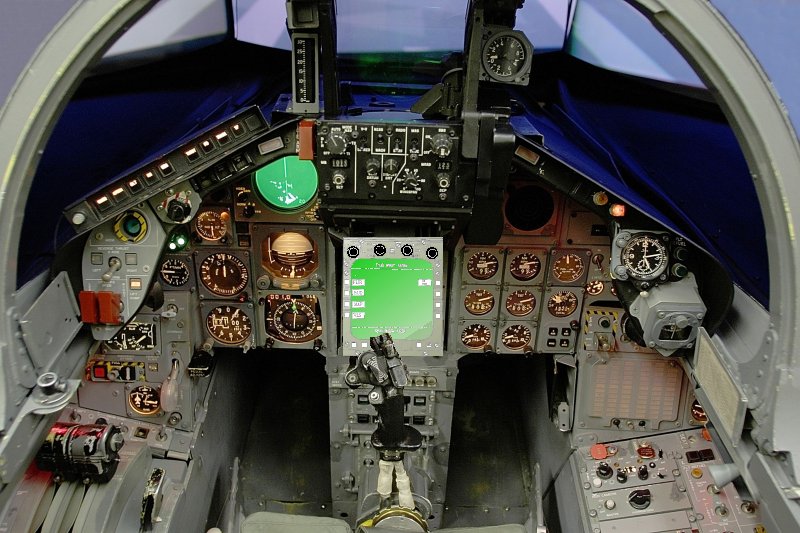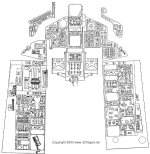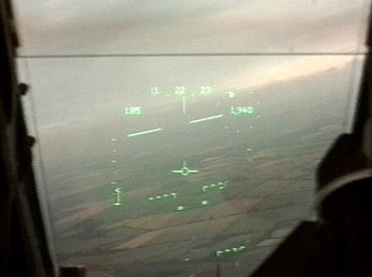

Move the mouse pointer over the instruments to get information about it (Explorer only). With a mousklick you jump to the explaining text. This works only with a full size picture, works not with a downsized picture on responsive displays!

| The entire front cockpit as a line drawing in an extra window: |  |
AOA (angle of attack) indicator
ADI - Attitude Director Indicator (artificial horizon)
The ADI comprises 3 different instruments:
Altimeter (barometrischer Höhenmesser)
APU and engine start switches
attention getter
Red flashing warning light that comes on when on the central Warning light panel CWP, a red or yellow warning light is set due to a system error. Depending on the severity of the incident, attention is also drawn to the warning light by a siren-like sound in the intercom, the so-called “Lyre Bird”.
Auto Pilot
canopy lever - lower, raise, lock and unlock the canopy
CEDAM - Combined Elektronic Display and Map -> Vollbild
Clock
CSI - Combined Speed Indicator
Knots calibrated airspeed and machnummer.
CWP - Central Warning Panel
Errors or faults occur in an important system of the aircraft if irregularities occur, a yellow-orange or red light appears on this warning sign, which shows where the error is. Certain combinations of several warning lights indicate specific errors. Additionally, to get the crew's attention, the two arrive attention getter and a distinctive tone in the intercom.
EGT - Exhaust Gas temperature
Emergency Jettison
Also called "panic button". With the MASS in "LIVE" depending on the position of the switch, all external loads or only those selected by the WSO on the SMS (storage management system) are jettisoned.
Engine RPM Indicator
EPS - Emergency Power Supply
Emergency energy supply for the case of complete hydraulic an electrical failure, consisting of:
ERWE - Enhanced Radar Warning Equipment
For an explanation see the "ECR-Tornado" page.
ESRRD (display for nav and low level flying radar)
Flap/Slat indicator
Fuel gauge
The fuel system consists of a rear and a front tank system, as well as tanks in the wings and external tanks under the wings and under the fuselage. The amount of fuel in the fuselage tank groups is displayed via two pointers, which can be used to see at a glance if there is a dangerous excess weight in the rear tank group (aft CG condition), because, for example. the left engine, the one from the front Tank group is supplied, had a higher fuel consumption. The Residual fuel from the wings and external tanks will be removed after actuation associated pressure switch is displayed.
Fuel flow indicator
Gear lever
g-meter
hook release
HSI - Horizontal Situation Indicator
The HSI is a multi-display instrument that provides control information for navigation and approach. To accomplish this task, it processes inputs from TACAN, UHF homing, ILS (not in German Tornados), SAHR and Main Computer MC. The instrument also provides the autopilot with directional information.
HUD - Head Up Display

Eingespiegelt werden im Normalflug Modus:
Im Angriffsmodus:
Hydraulic Pressure (Hydraulik Druck)
Late Arm Switch (Waffensicherungsschalter 2)
Neben der MASS der zweite Sicherungsschalter, der umgelegt werden muss, um die Waffen scharf zu machen und eine Auslösung zu ermöglichen.
Lift dump indication (Störklappen Lageanzeige)
LP cocks (Brandhähne)
In the event of a fire, this closes the main fuel valves. A fire that is developing or is already burning can no longer be ignited by additional fuel.
Landing/taxi light
The dazzling landing lights help the pilot at night to better estimate the distance to the ground when landing. They also signal to the air traffic controllers on the tower several miles before touchdown that the landing gear has been properly extended. Without recognizable landing lights, the aircraft will not receive permission to land, or will only receive permission to land after request (the lights can sometimes be defective). After landing, the pilot turns off the landing lights and at night turns on the taxi lights on the nose gear.
Master Armament Saftety Switch
Lockable rotary switch that can be switched from the "SAFE" position. on "LIVE" is to be switched in order to sharpen the weapons and activate the trigger circuits in conjunction with the Late Arm Switch.
Nozzle position
The diameter of the thrust nozzles can be changed and is automatically controlled by the engine control system depending on the exhaust gas temperature. The smaller the diameter, the faster the hot exhaust gases flow through and the greater the thrust. In the afterburner area, the nozzle must be opened to the maximum in order not to slow down the shock waves that arise in the exhaust gas cone. When rolling on the floor, they are also opened to the maximum (taxi nozzle) in order to keep the thrust as low as possible to protect the brakes.
Pedal adjust
Because you're in a fighter plane, not like in a car, or Passenger aircraft, which can move seats back and forth to adjust the space to the physical masses of the crew, in the Tornado the rudder pedals can be pushed back and forth.
Radar Altimeter
A small radar transmitter measures the height above ground between 0 and 5,000 feet.
Rudder Pedals
The pedals have two functions: moving the rudder and, when activated, controlling the aircraft on the ground using the nose wheel control.
Thrust reverse and position indicator
Due to the enormous asymmetries and yaw forces that can occur when full thrust reversal is applied to just one engine, it will shut down if it fails. Through a so-called "override switch" This logic can be bypassed and the thrust reversal can be carried out (sensitively) with only one engine running. A functioning thrust reverser is achieved through the display "rev - rev" displayed to the pilot after touchdown. Only now can he push the thrust levers forward to increase the braking effect.
Stick (Steuerknüppel)
Throttles
In addition to adjusting the engine performance in 3 ranges (DRY range, REHEAT range, COMBAT range), the engine levers serve a variety of other functions.
Trim indicator (Trimmanzeige)
Vertical Speed Indicator VSI
Displays the current rate of climb or descent. Important on the landing approach in order to set the correct descent speed for the glide path.
Whiskey Compass
Emergency compass filled with a liquid for cushioning. Rumors say that the liquid is alcohol, but this could never be proven due to the lack of an opening for draining (otherwise all emergency compasses would be undamped after a short time anyway).
Wingsweep lever
Although any wing sweep between 25 and 67 degrees is possible between the front and rear stops, the release of the Tornado by MBB/DASA/EADS only allows 3 positions: 25 degrees, 45 degrees and 67 degrees. The wings are swiveled manually by the pilot depending on the speed (25 degrees to approx. 350 knots/Mach 0.7, 45 degrees to approx. 450 knots/Mach 0.8 and 67 degrees for everything above that), as well as the presence of external loads on the outstations and the remaining fuel in the "wing tanks".
![]() © www.321tigers.de - Impress - Privacy Notice
© www.321tigers.de - Impress - Privacy Notice